Dog Stopped Dragging Paw Then Started Again
Knuckling in dogs is usually fairly easy to recognize but tin signal a variety of conditions. Integrative veterinarian, Dr. Buzby, discusses the five most common reasons for a dog to start knuckling on a front or back leg and shares some advice about caring for affected dogs.
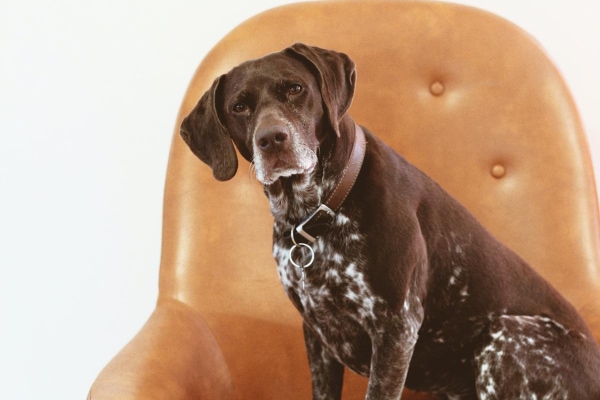
Lameness or trouble walking is one of the acme ten most common reasons why dogs are taken to see their veterinarians. When I see these patients in practice, near of them are limping or seem painful. Some dogs make it obvious which leg is afflicted. They might put a lilliputian bit of weight on their leg or none at all.
But plenty of my patients tend to "play information technology off" as naught by the time their possessor gets to the hospital. It's almost as if they are trying to say, "No, mom, I'm fine! Really!" All the same, it's a lot harder for my patients to hibernate their problem when they are knuckling over on one or more legs. Allow me tell y'all a story most 1 of my patients to help make my signal.
Encounter Marie
Marie was a seven-twelvemonth-old German Shepherd dog who presented 1 day for limping on her correct hind leg. She lived on a big property and absolutely loved to run the large border fence with her older brother, Charlie. Marie's mom would always tell me stories about Marie's first-class stride and svelte sprinting. Then she was very concerned virtually her pup on this particular twenty-four hour period.
On physical exam, Marie seemed normal except for balmy limping on the right hind limb whenever Marie took a pace forward. It seemed like she was dropping her hip as she stepped. Still, her hips flexed and extended well during my orthopedic evaluation.
Afterward gathering more data, I recommended X-rays for Marie. Thankfully, I didn't meet anything out of the ordinary. I didn't discover any signs of hip dysplasia in dogs or bone tumors. Her knees were as well healthy so a torn ACL in dogs seemed less probable. I recommended an anti-inflammatory medication for Marie and talked to her mom about restricting Marie's exercise for a week or ii to aid facilitate healing.
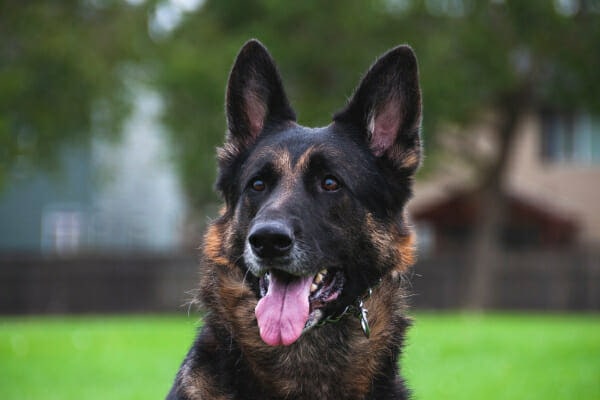
By the time Marie came back for her progress exam, she wasn't any better. In fact she was worse. She was still limping on the right hind limb but also seemed to be losing feeling in her leg. Her right paw was now knuckling and she was starting to testify similar signs on the left hind leg. She was also wobbling when she walked. Marie's mom mentioned that Marie seemed a little more lethargic. The big question in my listen was, "What is going on to cause the knuckling and rapid progression of signs?"
What is knuckling in dogs?
When a canis familiaris's foot rolls under as he or she stands or walks, nosotros refer to this a knuckling. Because the dog may end up dragging the foot, paw knuckling can cause physical injury to the top or sides of the foot. Overall, knuckling is far less common in dogs than limping, but information technology is still of import to recognize.
Why might a dog knuckle?
In some cases, paw knuckling occurs due to a problem with the domestic dog's nervous system. Normally, receptors in the tendons, muscles, and joints of the leg send signals through the nerves in the leg to the spinal cord and encephalon. This input is used to decide the position of the dog's human foot—is it upside down, right side upward, placed under the domestic dog, sticking out to the side, being held upwardly, etc. The term witting proprioception describes the nervous system's coordination of signals to indicate the position of a dog'south limb.
If something interrupts the signaling pathway, the canis familiaris will not know where the limb is in infinite or how information technology is positioned. This causes proprioceptive deficits, such as:
- Knuckling
- Placing the pes abnormally when standing
- Dragging a foot
- An uncoordinated gait (a dog that is wobbly and off remainder)
Alternatively, other dogs may have a normal neurologic arrangement just knuckle because their ligaments, tendons, or muscles are weak and cannot back up their weight. This tends to occur more oft in puppies or dogs with nutritional issues. However, frail senior dogs may likewise knuckle occasionally due to weakness.
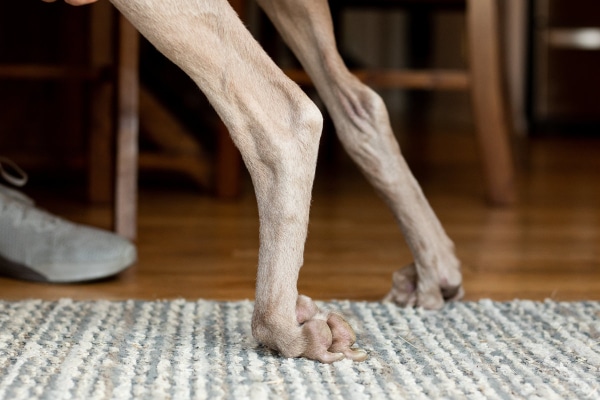
What causes knuckling in dogs?
At present that nosotros accept discussed some general reasons a canis familiaris may knuckle, let's movement on to some of the specific conditions your vet may consider if your dog is knuckling. This is not an exhaustive list simply is meant to cover the more than common issues.
ane. Spinal stroke (Fibrocartilaginous embolism or FCE)
Many individual basic known every bit vertebrae surround and protect the spinal cord. Cartilaginous discs sit between the vertebrae to act every bit shock absorbers and to give the dog's back and neck the power to flex, extend, and move side to side. These discs are great when they are healthy but can create quite a problem if they rupture.
Sometimes a small piece of a ruptured disc enters the blood stream and obstructs one of the small-scale vessels that supplies claret to a sure part of the spinal string. This is known as a fibrocartilaginous embolism (FCE) or spinal stroke in dogs. FCEs are more mutual in young giant and big breed dogs. Nonetheless, they may also occur in some small brood dogs, especially Shelties and Schnauzers.
Affected dogs may suddenly weep out when running, jumping, or playing then immediately become weak or paralyzed. They may knuckle on one or more than limbs, accept an uncoordinated gait, and sometimes be unable to walk at all. After the initial moment of pain, dogs with a FCE are generally not-painful. This is one of the things that may brand a vet suspicious of a FCE (rather than a different cause of spinal cord trauma) during the concrete exam.
Your veterinary may recommend X-rays, which are usually normal in cases of FCE. Definitive diagnosis requires an MRI. This usually ways referral to a veterinary neurology specialist. Unfortunately, there is no definitive treatment except for supportive care and time. Some dogs may recover over several days to weeks but in other cases they remain permanently paralyzed.
2. Intervertebral disc disease (IVDD)
Remember how we talked about the discs that sit between the vertebrae? In improver to causing a FCE they can too crusade intervertebral disc disease( IVDD) in dogs, which is divided into two types. In type I IVDD, the disc acutely ruptures into the spinal canal, and in type II IVDD, the disc degenerates over fourth dimension and begins to bulge. Both of these situations put force per unit area on the spinal string, which sits merely to a higher place the disc. While IVDD tin occur anywhere in the spine, information technology happens nigh oftentimes in the cervical (i.e. neck) or thoracolumbar surface area (i.e. mid-back near the junction of the concluding rib and the first few lumbar vertebrae).

Afflicted dogs may become weak or paralyzed in their rear limbs (if the problem is in the thoracolumbar region) or all four limbs (if the trouble is in the cervix). They are often painful in their back or neck and may knuckle or drag their feet. Severely afflicted dogs may be paralyzed and in some cases are unable to urinate on their ain.
If your domestic dog develops signs of IVDD, your veterinary may recommend an Ten-ray to await for signs of a ruptured or mineralized disc. Sometimes, a veterinary neurologist may inject dye around the spinal string then take an X-ray (i.e. perform a myelogram) or use an MRI or CT to discover the area(south) of compression.
IVDD treatment
Some dogs with IVDD can recover without surgery later strict residuum, medications and supportive intendance (more on that later). However, others will need IVDD surgery for dogs to remove the ruptured portion of the disc and accept force per unit area off the spinal cord. For a paralyzed dog, emergency back or cervix surgery gives the best chances of walking over again. Without surgery, paralysis may be permanent. Sometimes even subsequently surgery, some degree of weakness or paralysis may persist with severe spinal cord injuries.
iii. Degenerative Myelopathy
Degenerative myelopathy in dogs is a chronic affliction of the spinal string that causes progressive paralysis. Information technology starts out looking similar arthritis or hip dysplasia, which makes it hard to diagnose right away. Dogs may initially just exist limping on one of their hind limbs merely otherwise appear normal.
However, as the affliction progresses, it affects the other hind leg and causes a dog to be weak, have a wobbly gait, and knuckle on one or both rear legs. Eventually, the dog becomes completely paralyzed and unable to command his or her bowels or bladder.
Degenerative myelopathy affects middle-aged and older dogs. Information technology is virtually common in German language Shepherds, Huskies, Retrievers, and Corgis. The exact cause of degenerative myelopathy is unknown. However, there is a mutated gene known as SOD-one that puts dogs at loftier hazard for developing degenerative myelopathy.
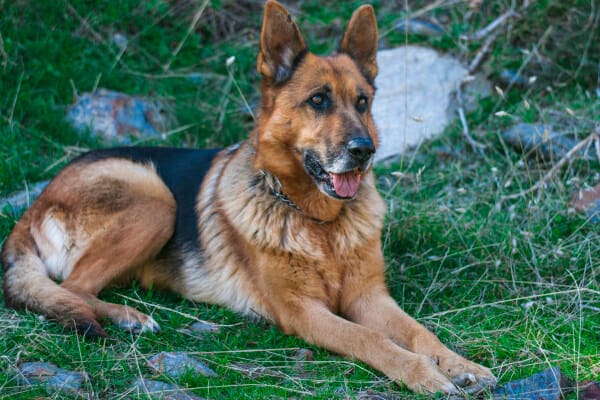
There is no definitive test for degenerative myelopathy. Claret testing tin await for the presence of the mutated factor. The presence of the gene plus signs consequent with degenerative myelopathy get in the near likely diagnosis.
Unfortunately, clinical signs can progress over the span of a few weeks to several months in most cases. Occasionally a canis familiaris may defy the odds and make it a year or more. Just overall the prognosis is poor because in that location is no cure. Therapy with aminocaproic acid, n-acetylcysteine, prednisone for dogs, and vitamin supplements may possibly help irksome the progression of degenerative myelopathy.
Back to Marie
Unfortunately for Marie, she ended upwards having degenerative myelopathy. When I talked to her mom nearly the condition, she agreed that this sounded exactly like what Marie was experiencing. Nosotros decided to submit a blood sample for gene testing, and information technology came back positive for the SOD-1 mutation. Marie's mom made sure to go on her comfortable and spoiled for the post-obit two months of Marie's life.
iv. Wobbler Syndrome
This status gets its name from the wobbly gait that about affected dogs exhibit. The exact cause is yet under investigation, but it is possible that it may have a genetic basis since information technology is most mutual in Bully Danes and Dobermans. Dogs with wobbler syndrome typically have spinal string compression in their neck from either an abnormally narrow spinal culvert plus intervertebral disc herniation or narrowed spinal canal due to changes to the surrounding bone. In improver to compressing the spinal cord, these changes may also put pressure on the nerves as they exit the spinal string.
Dogs with wobblers tend to take an unsteady gait which is more pronounced in the rear legs. They may besides knuckle their paws, take difficulty getting upwardly, or appear weak. Nerve pinch can cause significant pain and afflicted dogs may walk with their heads lowered. Signs tend to show up in Dandy Danes around the age of iii years and Dobermans around six years.
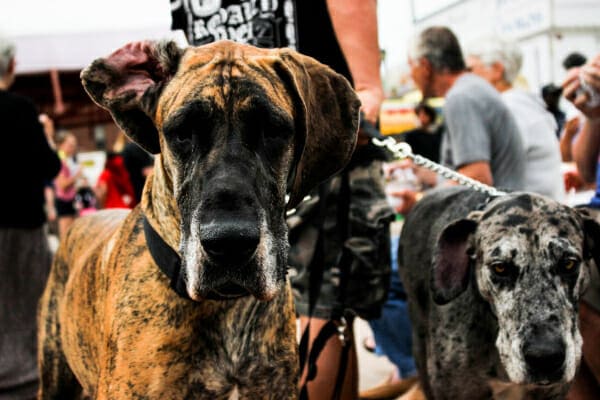
If your vet suspects your dog may have wobbler syndrome he or she will most probable start past taking X-rays to look for any bone changes or signs of other atmospheric condition. Then he or she may refer you to a veterinarian neurologist for advanced imaging such as a myelogram, CT, or MRI.
Some dogs with wobblers will exercise well with medications, supportive care, and lifestyle changes such every bit avoiding leashes that go effectually the neck. Other dogs may benefit from surgery. A written report in the Journal of the American Veterinary Medical Association demonstrated that the average survival time for dogs with wobblers is approximately four years regardless if they had medical or surgical management.
v. Carpal flexural deformity
This condition is a chip unlike than everything else on the list because it doesn't come from a trouble with the nervous system. The verbal cause is unknown. However, researchers believe information technology may upshot from some combination of genetic predisposition plus nutritional factors in chop-chop growing puppies. It is thought that a diet with backlog protein and few other core elements like carbohydrates can cause painful growth spurts that result in this condition.
Carpal flexural deformity generally affects large and behemothic brood puppies, usually younger than four months of age. As the name indicates, it affects the puppy'southward carpus (i.e. wrist—the joint on the front leg betwixt the elbow and the pes). The puppy may have hyperextension, hyperflexion or full general laxity (i.east. looseness) of the carpus. Additionally, the carpus could be bowed inwards (i.eastward. varus deformity) or outward (i.e. valgus deformity). This combination of changes may make the carpus appear to exist knuckled over.
The good news is that about affected dogs ameliorate within one to three weeks of diagnosis. Sometimes a diet change (i.due east. to a balanced or energy restricted nutrition) and/or soft splints to support the legs may be beneficial during the recovery menstruation.
How tin can I help my dog who is knuckling?
Every bit you lot tin can see, there are many reasons a dog may be knuckling. Some may resolve with supportive care and time while others may require surgery. And still others may never get away. In that location are many ways you can support your canis familiaris afterwards he or she is diagnosed with a condition that causes knuckling.

1. Give the gift of traction
My signature production, Dr. Buzby'due south ToeGrips® domestic dog boom grips, can piece of work wonders for dogs who have an unsteady gait and are knuckling, prone to slipping, or weak. They tin assistance your dog regain traction and walk with confidence on slippery floors that otherwise might pose a mobility problem.
Plus, ToeGrips somehow seem to provide feedback to the brain and spinal cord to help enhance a dog'southward conscious proprioception. If you remember from the beginning, conscious proprioception is the nervous system'due south mode of telling where a canis familiaris's limbs are in space. Dogs who are knuckling normally practice so because they accept contradistinct conscious proprioception. ToeGrips may help them by reminding the domestic dog's brain to pick up the paws, thus improving the dog's gait.
ToeGrips non just assistance these dogs with stability and confidence, they can likewise serve to take the brunt of chronic trauma to the nails from dragging. Over time, if the canis familiaris's conscious proprioception does non improve, the nails can start to wear in a funny blueprint or even wear back to encarmine "stumps." ToeGrips, when glued in place, can protect the boom from this demise.
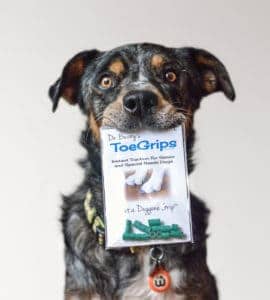
For dogs who are scuffing or dragging their feet, we recommend an alternative application method—affixing ToeGrips to the nails with super glue. This is not necessary for most dogs, but for dogs who elevate/scuff their paws, that contradistinct gait tends to tug the ToeGrips off the nails. Super Gum is the simple solution to go along the ToeGrips deeply in position. I demonstrate application of ToeGrips using glue in this video:
ii. Reduce inflammation and pain
Some conditions such equally IVDD and wobbler syndrome may crusade considerable pain and inflammation. Thus, your vet may prescribe medications such as not-steroidal anti-inflammatories (NSAIDs), tramadol for dogs, gabapentin for dogs, steroids like prednisone, or other medications.
Always give all medications every bit directed and notify your vet immediately if y'all observe whatever apropos side effects. Never decide to give your dog your ain pain medications as man pain-relievers like Advil can be toxic for dogs.
Some dogs may as well do good from laser therapy for dogs, which has several benefits including:
- Pain relief
- Improved healing
- Decreased swelling and inflammation
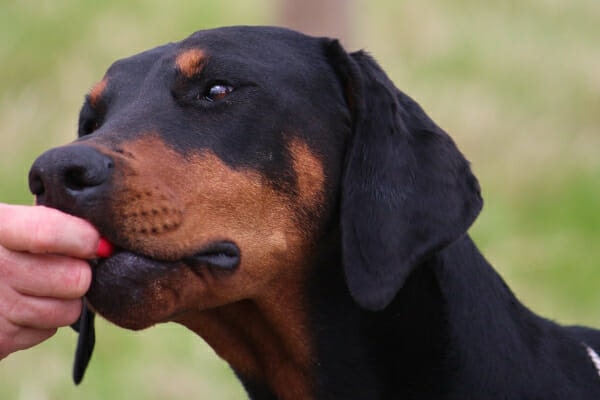
three. Help your domestic dog become up and walk
Some dogs who are knuckling may also be weak or paralyzed, making it difficult for them to stand or move from place to identify. Two of my favorite mobility aids are the GingerLead® Support and Rehabilitation Harness, and the Help 'Em Upwardly® Mobility Harness. Both products can help salve your back and are much more comfy for you and your dog than using a towel as a sling (although that does piece of work in a pinch).
Permanently paralyzed or significantly weak dogs may also do well with a wheelchair in some situations. Your vet can recommend some good companies to purchase a wheelchair from. Alternatively, there are plans online for making a doggy wheelchair. Ever ensure the wheelchair fits your dog well (which is where purchasing it through a reputable visitor with good client support can help) and check your dog often for any rub sores.
iv. Find a rehab vet
In many situations, dogs can do good from physical therapy just like people exercise. You may be able to detect a veterinary professional person who specializes in rehabilitation and concrete therapy in your expanse. Alternatively, some general practise vets also provide rehab services.
The rehab vet can evaluate your dog and help blueprint an practice programme specifically for him or her. They will most likely do some exercises with your dog and teach you how to do the exercises at home too. Some rehab vets may besides take an underwater treadmill or a hydrotherapy pool. Both of these tin can be very benign as the buoyancy of the water volition help back up your dog. Plus, many dogs quite savor their time in the water!
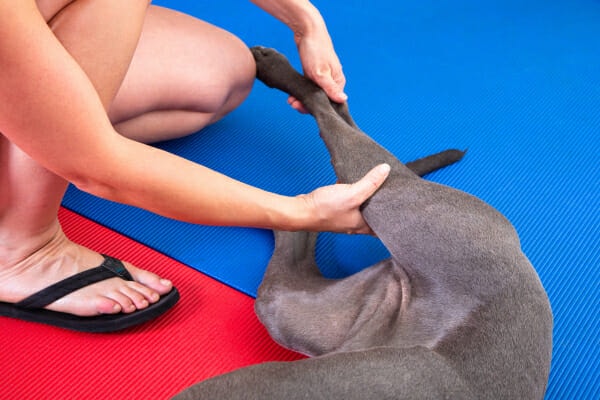
5. Protect your dog'south anxiety
If your domestic dog is dragging his or her feet or knuckling, sometimes the tops or side of the feet may get scraped up. This is especially a problem when walking on more abrasive surfaces similar concrete. To protect your domestic dog's feet, try to stick to soft surfaces like grass while outside. If your dog requires hind terminate back up for walking, try to hold him or her in a position where the legs aren't dragging but the domestic dog can withal effort to walk to build force (if advisable).
You can as well consider using PawZ Boots for short periods of time. They are thin (think latex balloon) so they don't pose as big of a tripping take chances as bigger beefy booties but still offer some protection. I always caution owners to read the instructions carefully when using PawZ, considering they practise have the potential to event obstruct circulation to the paw and are non intended to exist left on continuously.
The most important thing yous can do for your dog is to stay in shut contact with your vet and any specialists yous are working with. Since there are a variety of causes of knuckling with different outlooks and treatments, the first footstep is to get a diagnosis as shortly as possible.
Once you lot know what yous are dealing with, enquire all your questions and do your research (using reputable sources) to find out as much equally possible near your domestic dog's status and how y'all can help. And of grade, keep loving on your dog and treasure the time you take together. Take confidence that you can tackle whatever is in forepart of you.

Have you noticed your dog knuckling? What was the cause and how did you lot help your pup?
Please annotate below.
Source: https://toegrips.com/knuckling-in-dogs/
0 Response to "Dog Stopped Dragging Paw Then Started Again"
Post a Comment